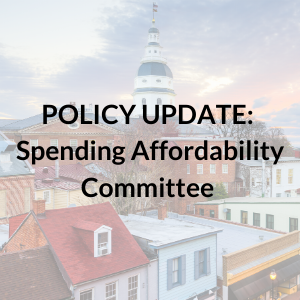Policy Update: Spending Affordability Committee Briefing

Last Wednesday, the annual Department of Legislative Services (DLS) briefing to the Spending Affordability Committee and the fiscal committees took place in Annapolis. This event is viewed by many as the real start of the legislative season. In December, the Spending Affordability Committee will recommend a limit or ‘cap’ for the amount of recurring spending to be approved by the General Assembly in the 2020 Session. Since the mid-1980’s, that limit has been enforced in most years – so the principal ‘macro’ budget decision could be made before Christmas, when the Governor’s budget is finalized.
Last week we learned two things – that the budget picture for the next fiscal year (FY 2021) isn’t nearly as dire as it looked back in April (which was really grim), and based on the current DLS projections, there is cash deficit of $247 million pending, and a structural deficit of $441 million.
Since April:
-
- The closeout from last fiscal year (2019) produced $256 million in extra cash. Current (FY 2020) and next year (FY 2021) revenue projections have been raised by a total of $174 million and $130 million respectively, and the Governor did not release the $238 million in 2020 spending “fenced off “ by the legislature.
- Some projected FY 2021 costs now seem to be declining, the biggest factors being lower caseload and enrollment projections, and greater savings in costs of state debt.
These positives in the new forecast were only partially offset by other higher costs or diversions of General funds to other needs. DLS pointed to three additional policy alternatives that could help address the remaining cash deficit and balance the budget. These were:
-
- Keeping less in the “Rainy Day” reserve fund balance, moving from 6% to 5% of General Fund revenues
- Funding the Washington Metropolitan Area Transit Authority (WMATA) mandate from the Transportation Trust Fund rather than the General Fund as planned
- Elimination of FY 21 employee raises.
Beyond that, the briefing described how the Kirwan Workgroup recommendations moderated the out year structural deficit growth – compared to the Kirwan Commission’s earlier recommendations – and detailed the growth components of overall spending and revenues, reviewed state debt policies, and summarized the out-year capital and transportation spending programs.
The briefing document and its appendix are on the General Assembly website. The recorded briefing is also available. Contact Henry Bogdan for more information
